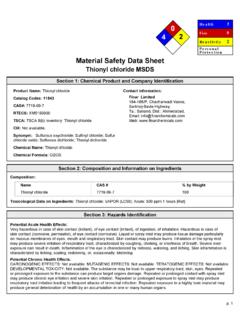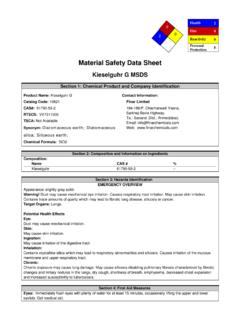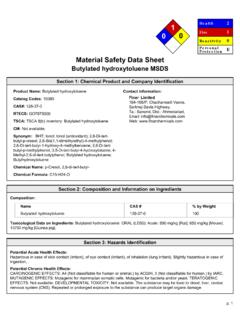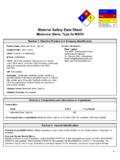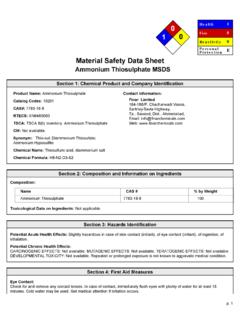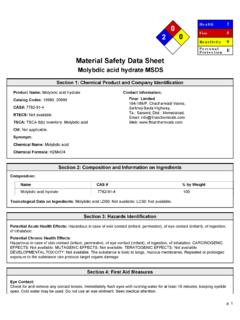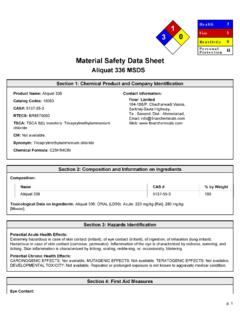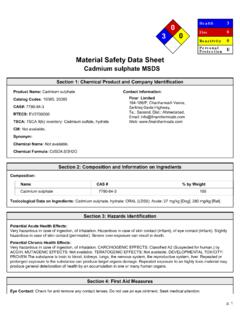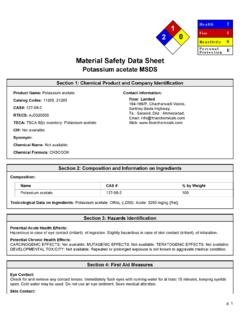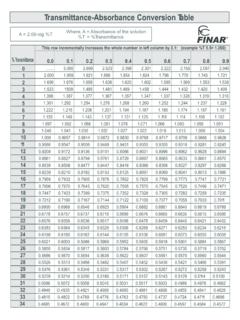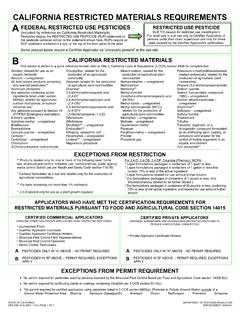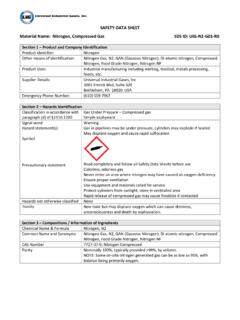Transcription of Material Safety Data Sheet - Finar Chemicals
1 P. 1 3 2 0He a lt hFireRe a c t iv it yP e rs o n a lP ro t e c t io n230 HMaterial Safety data SheetBenzene MSDSS ection 1: Chemical Product and Company IdentificationProduct Name: BenzeneCatalog Codes: 10270, 20270, 30270 CAS#: 71-43-2 RTECS: CY1400000 TSCA: TSCA 8(b) inventory: BenzeneCI#: Not : Benzol; BenzineChemical Name: BenzeneChemical Formula: C6-H6 Contact Information: Finar Limited184-186/P, Chacharwadi Vasna, Sarkhej-Bavla Highway, Ta.: Sanand, Dist.: Ahmedabad, Email: Web: 2: Composition and Information on IngredientsComposition:NameCAS #% by WeightBenzene71-43-2100 Toxicological data on Ingredients: Benzene: ORAL (LD50): Acute: 930 mg/kg [Rat].
2 4700 mg/kg [Mouse]. DERMAL (LD50):Acute: >9400 mg/kg [Rabbit]. VAPOR (LC50): Acute: 10000 ppm 7 hours [Rat].Section 3: Hazards IdentificationPotential Acute Health Effects:Very hazardous in case of eye contact (irritant), of inhalation. Hazardous in case of skin contact (irritant, permeator), ofingestion. Inflammation of the eye is characterized by redness, watering, and Chronic Health Effects:CARCINOGENIC EFFECTS: Classified A1 (Confirmed for human.) by ACGIH, 1 (Proven for human.) by IARC. MUTAGENICEFFECTS: Classified POSSIBLE for human.
3 Mutagenic for mammalian somatic cells. Mutagenic for bacteria and/or EFFECTS: Not available. DEVELOPMENTAL TOXICITY: Classified Reproductive system/toxin/female[POSSIBLE]. The substance is toxic to blood, bone marrow, central nervous system (CNS). The substance may be toxic toliver, Urinary System. Repeated or prolonged exposure to the substance can produce target organs 4: First Aid Measuresp. 2 Eye Contact:Check for and remove any contact lenses. In case of contact, immediately flush eyes with plenty of water for at least 15minutes.
4 Cold water may be used. WARM water MUST be used. Get medical attention Contact:In case of contact, immediately flush skin with plenty of water. Cover the irritated skin with an emollient. Remove contaminatedclothing and shoes. Wash clothing before reuse. Thoroughly clean shoes before reuse. Get medical Skin Contact:Wash with a disinfectant soap and cover the contaminated skin with an anti-bacterial cream. Seek immediate :If inhaled, remove to fresh air. If not breathing, give artificial respiration.
5 If breathing is difficult, give oxygen. Get medicalattention if symptoms Inhalation:Evacuate the victim to a safe area as soon as possible. Loosen tight clothing such as a collar, tie, belt or waistband. Ifbreathing is difficult, administer oxygen. If the victim is not breathing, perform mouth-to-mouth resuscitation. Seek :Do NOT induce vomiting unless directed to do so by medical personnel. Never give anything by mouth to an unconsciousperson. If large quantities of this Material are swallowed, call a physician immediately.
6 Loosen tight clothing such as a collar,tie, belt or Ingestion: Not 5: Fire and Explosion DataFlammability of the Product: Temperature: C (928 F)Flash Points: CLOSED CUP: C (12 F). (Setaflash)Flammable Limits: LOWER: UPPER: of Combustion: These products are carbon oxides (CO, CO2).Fire Hazards in Presence of Various Substances:Highly flammable in presence of open flames and sparks, of heat. Slightly flammable to flammable in presence of oxidizingmaterials. Non-flammable in presence of Hazards in Presence of Various Substances:Risks of explosion of the product in presence of mechanical impact: Not available.
7 Risks of explosion of the product inpresence of static discharge: Not available. Explosive in presence of oxidizing materials, of Fighting Media and Instructions:Flammable liquid, soluble or dispersed in water. SMALL FIRE: Use DRY chemical powder. LARGE FIRE: Use alcohol foam,water spray or Remarks on Fire Hazards:Extremely flammable liquid and vapor. Vapor may cause flash fire. Reacts on contact with iodine heptafluoride tetrafluoroborate is as very powferful oxidant. The addition of a small particle to small samples of benzene, atambient temperature, causes ignition.
8 Contact with sodium peroxide with benzene causes ignition. Benzene ignites in contactwith powdered chromic anhydride. Virgorous or incandescent reaction with hydrogen + Raney nickel (above 210 C) andbromine Remarks on Explosion Hazards:Benzene vapors + chlorine and light causes explosion. Reacts explosively with bromine pentafluoride, chlorine, chlorinetrifluoride, diborane, nitric acid, nitryl perchlorate, liquid oxygen, ozone, silver perchlorate. Benzene + pentafluoride andmethoxide (from arsenic pentafluoride and potassium methoxide) in trichlorotrifluoroethane causes explosion.
9 Interactionp. 3of nitryl perchlorate with benzene gave a slight explosion and flash. The solution of permanganic acid ( or its explosiveanhydride, dimaganese heptoxide) produced by interaction of permanganates and sulfuric acid will explode on contact withbenzene. Peroxodisulfuric acid is a very powferful oxidant. Uncontrolled contact with benzene may cause explosion. Mixturesof peroxomonsulfuric acid with benzene 6: Accidental Release MeasuresSmall Spill: Absorb with an inert Material and put the spilled Material in an appropriate waste Spill:Flammable liquid.
10 Keep away from heat. Keep away from sources of ignition. Stop leak if without risk. Absorb with DRY earth,sand or other non-combustible Material . Do not touch spilled Material . Prevent entry into sewers, basements or confinedareas; dike if needed. Be careful that the product is not present at a concentration level above TLV. Check TLV on the MSDSand with local 7: Handling and StoragePrecautions:Keep locked Keep away from heat. Keep away from sources of ignition. Ground all equipment containing Material .
